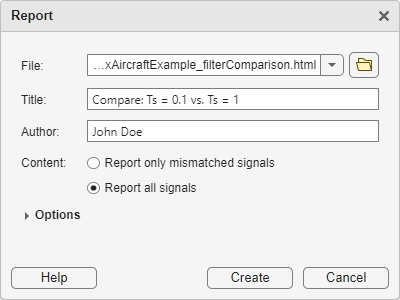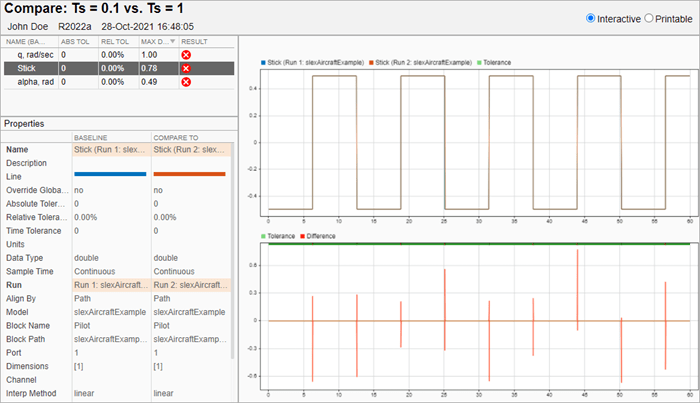Create Interactive Comparison Reports
This example shows how to create an interactive web-based comparison report to share and archive results for comparisons you perform using the Simulation Data Inspector. The report is a self-contained HTML file, and viewing the report only requires a web browser. You can use the report to analyze the comparison results similarly to how you would in the Simulation Data Inspector. You can change the layout of the report between the interactive view and a printable view.
This example shows how to create an interactive comparison report using data loaded into the Simulation Data Inspector from a session file. For information about importing data into the Simulation Data Inspector or logging data from a simulation, see View Simulation Data in Simulation Data Inspector.
Load and Compare Data
Open the Simulation Data Inspector and load the session file data into the Simulation Data Inspector.
Simulink.sdi.view
Simulink.sdi.clear;
Simulink.sdi.load("dataToCompare.mldatx");The session file contains data created by simulating the model slexAircraftExample. Both simulations use the square wave input from the Pilot block in the model. Each simulation uses a different time constant for the input filter. The first run contains simulation results for an input filter time constant of 0.1. The second run contains simulation results for an input filter time constant of 1.
To analyze the effect of changing the input filter time constant, compare the runs that contain the data for each simulation.
In the Simulation Data Inspector, navigate to the Compare tab.
From the Baseline list, select
Run 1: slexAircraftExample.From the Compare to list, select
Run 2: slexAircraftExample.Click Compare.
Alternatively, you can compare the runs programmatically using the Simulink.sdi.compareRuns function.
runIDs = Simulink.sdi.getAllRunIDs; runID1 = runIDs(end-1); runID2 = runIDs(end); diffRes = Simulink.sdi.compareRuns(runID1,runID2);
Generate Interactive Comparison Report
When you generate a comparison report to save the comparison results, specify:
The data you want to include in the report.
The title and author for the report.
The filename and location.
Options for avoiding overwriting existing reports and shortening block paths. Consider shortening block paths when you log data throughout a model hierarchy.
To create the report, click Report ![]() .
.
For this example:
In the File text box, enter the folder path followed by the filename
slexAircraftExample_filterComparison.html.In the Title text box, enter
Compare: Ts = 0.1 vs. Ts = 1.Under Content, select either option. In this example, all signals in the comparison do not match, so the contents of the report are the same for either option.
Click Create Report.

The generated report automatically opens in the system browser. By default, the Simulation Data Inspector saves the report with the filename New_Report.html in a folder called sdireports in the working directory.
Inspect Comparison Results Using Interactive Report
The interactive report information and layout is similar to what you see on the Compare pane of the Simulation Data Inspector. In the comparisons table, you can select the signal result you want to view in the plots.

The Properties table shows the metadata for the compared signals and highlights metadata that differs. Scroll in the Properties table to see all the metadata. When the comparison contains more signals than fit in the results table, you can scroll in the comparison table to inspect the results for each signal comparison and sort the signals in the table by the data in each column.
For example, to sort the results by the maximum difference, click the Max Diff column.

You can adjust the size of the panes in the report by dragging the borders and adjust the widths of the columns in each table by dragging the divisions between the column headings. For example, since the comparison table does not use all the space in the signals pane, you could make the Properties pane larger.

The information in the table indicates that the comparison results for the Stick signal are out of tolerance with a maximum difference of 0.78. In the model, the Stick signal is the output from a Signal Generator block, and the filter time constant should not affect the block output. Select the Stick signal to investigate the comparison results.

By inspecting the plots, you can see that the differences occur at the rising and falling edges of the square wave. The slexAircraftExample model uses a variable-step solver. The differences occur because the new time constant value changes the system dynamics, and the solver calculates slightly different time steps for the second simulation. The transition of the square wave is sharp, so small timing differences can result in large differences in magnitude.
Because the differences in the Stick signal are due to modeling rather than a real change in system dynamics, you could go back to the Simulation Data Inspector and specify a small time tolerance (for example, 0.01) for the Stick signal so the comparison results are within tolerance. To share the updated results, you can generate a new comparison report.
Print Comparison Report
After finalizing the analysis and presentation of the comparison results, you can print a comprehensive view of the results using the interactive web report. To switch to the printable view, select the Printable radio button, or press Ctrl+P to see a print preview in the browser. In the printable view, the metadata and plots for all signals are stacked, with the summary table at the top.